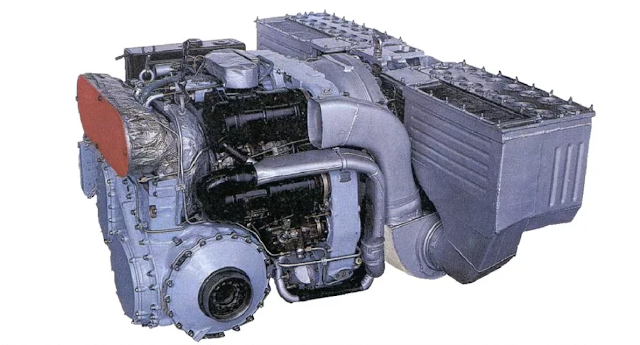Paint and camouflage
To camouflage AFVs and increase
the difficulty of being spotted using day-night observation devices, a
variety of different paint schemes paired with specifically designed camouflage patterns can be used. Vehicles are painted using a
base coating of enamel, which has chemical durability and specific spectral
characteristics. To add camouflage, secondary colour enamel spots are added
onto the surface of the vehicle.
Camouflaging can be achieved by combining different camouflage methods into one single design: colour differentiation between primary
paint coat and secondary colour spots, different values of reflection
coefficients in the infrared (IR) spectrum, and a special pattern design, deforming the
visible silhouette of a vehicle.
To create basic camouflage
schemes, 2 different enamels were used: HV-518 is used as the base paint and
NC-1200 for spots. Enamel HV-518 would protect the vehicle from being detected
by passive IR devices only in the spectral range over 0.85 micrometres, but
would be detectable when observed by active IR devices. Enamel NC-1200 assisted
in camouflaging objects stationed in green vegetation and at night from active
IR devices.
AFVs using two-colour coating with
HV-518 and NC-1200 enamels had their probability of being detected on IR devices reduced by 10%-15%.
To increase the masking
efficiency, instead of enamels HV-518 and NC-1200, a set of green-protective
and silver-yellow colour HS-5146 enamels was developed. Which is a compound of pigments and fillers in a solution of copolymer A-15-0 in a mixture of
organic solvents with a polyisocyanate biuret hardener.
HS-5146 enamels of various
colours can be applied by brush, dipping, and pneumatic spraying on a metal
surface primed with two layers of AK-070 primer.
 |
| A variety of enamel and paint is recommended for |
During the late 1970s and 1980s, a 'standardized' chart was developed. Depicting the utilization of enamel and paint colours to create deforming camouflage patterns in different climates. Three main categories were drafted: vegetation, desert-mountainous and snow.
Deforming vegetative camouflage utilized either HV-518 (khaki) or HS-5146 (protective green) as the main base paint, which would cover 60% of the surface. Additionally, 2 HS-5146 colour types and 1 EVA-524 colour type would be applied: HS-5146 (black) as the 1st additional colour type and HS-5146 (grey-yellow) along with EVA-524 (light grey) as the 2nd additional colour type. Each of the additional colours would cover 20% of the remaining surface.
Deforming desert-mountainous camouflage consisted of HS-5146 (grey-yellow) as the base paint, which would cover 80% of the surface. For dryer regions, a more extensive selection of additional colours was available: HS-5146 (black), HS-5146 (protective green), HV-518 (khaki), and EVA-524 (dark grey). These colours would cover 20% of the remaining surface.
Deforming snow camouflage used EVA-524 (white) as its base paint and would cover 80% of the surface. HS-5146 (protective-green or black) and HV-518 (khaki) would cover the remaining 20% of the surface.
Coating vehicles using HS-5146 offered advantages compared to the serial XV-518 enamel. HS-5146 offered better abrasion resistance by almost 3 times and is sturdier by about 30% compared to HV-518. HS-5146 and HV-518 have the same impact strength and elasticity. HS-5146 enamel has good adhesion capabilities to steel, aluminium and titanium alloys.
The results of corrosion tests
showed the advantage of HS-5146 enamels in terms of protective properties over
HV-518 and NC-1200 enamels. When kept in hydrostat G-4 of samples painted with
HS-5146 enamel, the bubbling of the coating appeared only on the 113th day of testing
and affected 2%-5% of the sample surface, while the destruction of HV-518
enamel began on the 30th day (small flaking on 15% of the surface), and after
113 hours during the test days, small bubbles appeared on approximately 80% of
the painted surface. The coating with enamel NC-1200 begins to change on the
first day of testing. After 44 days, bubbling takes up about 40% of the painted
surface, and on the 113th day, the coating is destroyed. During immersion tests
in a 100% solution of NaCl and in a salt mist chamber, it was revealed that
HS-5146 enamel had a slight advantage over the other enamel types.
The compatibility features of
HS-5146 green-protective and grey-yellow enamels were studied. At the same
time, compatibility tests of HS-5146 green-protective and HV-518 enamels were
conducted.
These compatibility tests were
conducted due to a large portion of vehicles being delivered for re-paints, which came painted in HV-518. The compatibility of enamels was determined by
the following coating qualities: adhesion, impact strength and elasticity. The
test results showed that the best combination of HS-5146 green-protective
enamel with HS-5146 grey-yellow enamel and HV-518 enamel with HS-5146
green-protective enamel is achieved by sanding the previous layer of enamel,
subsequently removing the remaining paint flakes with compressed air and
degreasing the surfaces with white spirit or an aqueous detergent solution
based on Synthol with phosphoric acid.
Two-tone colouring is performed
by applying the first coating of enamel HS-5146 green-protective colour to the entire outer
surface of a vehicle, followed by applying enamel HS-5146 grey-yellow colour on
a pre-determined pattern, which is developed for each specific vehicle. The design pattern is made based on the vehicle's silhouette and overall design characteristics.
Compared to serial-production enamel paints, HS-5146 has a shorter service life and requires a more complicated application method due to needing 2 primer coatings of AK-070 before being applied on a vehicle. While HV-518 only requires a single primer coating of FL-03K.
During field trials, vehicles painted with HS-4156 deforming camouflage performed better than vehicles painted with HV-518. Camouflage patterns using HS-5146 had a 15%-20% lower chance of being spotted.
References:
- Вопросы оборонной техники, научно-техническиой сборник. Серия XX - Выпуск 98 (1981)
- АЛЬБОМ ОБРАЗЦОВ РИСУНКОВ ДЕФОРМИРУЮЩЕГО ОКРАШИВАНИЯ ВООРУЖЕНИЯ И ВОЕННОЙ ТЕХНИКИ. ЧАСТЬ IV: ИНЖЕНЕРНАЯ И АВТОМОБИЛЬНАЯ ТЕХНИКА. ИЗД: МОСКВА ВОЕННОЕ ИЗДАТЕЛЬСТВО 1989
.jpg)





Comments
Post a Comment